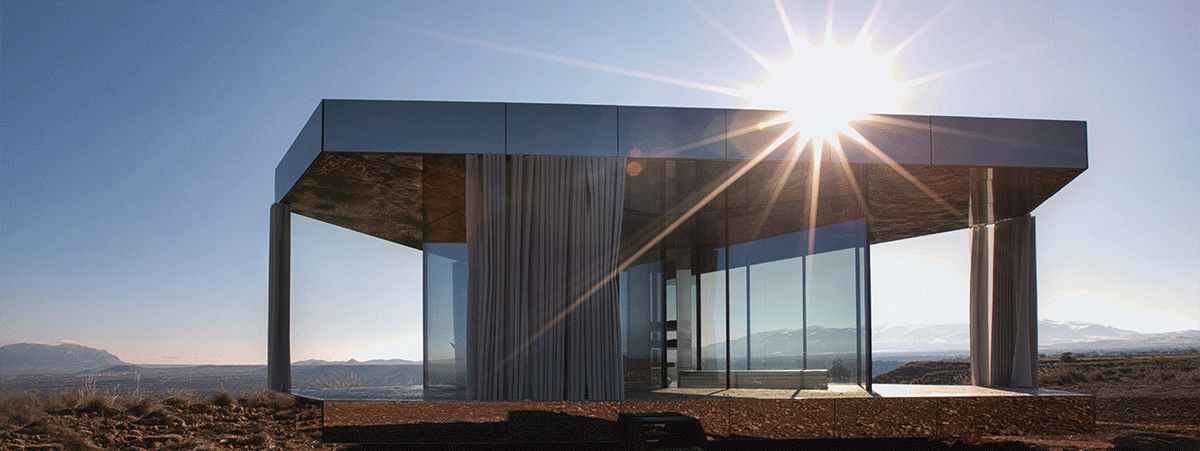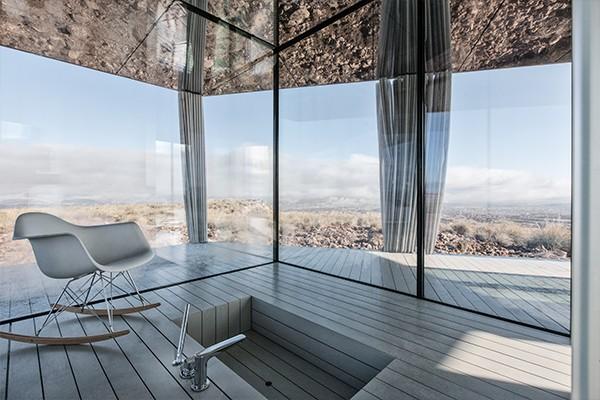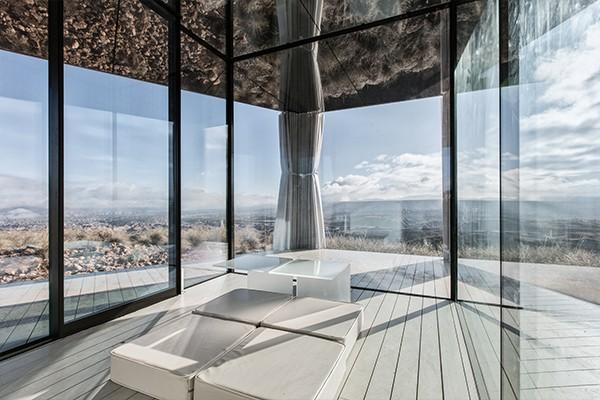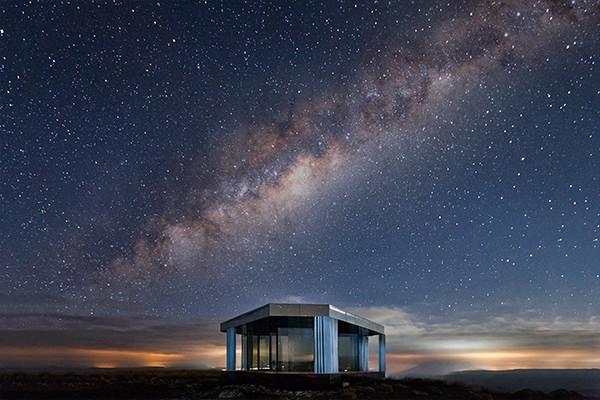The Sustainable Glass House of Gorafe in Netflix's Series ‘Black Mirror’
Guardian Glass builds a sustainable glass habitat in the middle of the desert, cameos in Netflix series ‘Black Mirror’
In the middle of Spain’s Gorafe Desert, there sits a solitary glass structure in the middle of a desolate stone landscape. Called La Casa del Desierto (or, desert house), this three-sided glass house serves as a testament to the capabilities of coated glass products, specifically those from Koch company Guardian Glass.
Watch: Guardian Glass Europe - The house of the desert - episode 1
“I can tell you the idea was so ambitious that, in our first meeting, the climate engineer and I were like, ‘Ah, forget it … it’s not possible,’” said Tom Kovacs, manager of the Guardian Glass European Technical Advisory Center.
In Gorafe, temperatures can rise to 113 degrees Fahrenheit during summer and drop to 14 degrees Fahrenheit in winter – well below freezing. Within a 24-hour period, the temperature can swing radically in either direction. A habitable structure would need to cover both extremes. In fact, most of the homes in Gorafe are built into the cliffside, where they can stay cool, but stay very dark.
“The climate of Gorafe is quite extreme. When I first heard about the project, I was amazed... It’s like building a greenhouse in the middle of the desert,” said Miguel Perez Navarro, Mayor of Gorafe.
“The idea was to show people just how important glass can be in the experience of your living space,” said Charlotte Bucheler, residential communications leader with Guardian Europe. “We decided one of the best ways to prove that was to build a house in the middle of the desert. Because, if glass can be efficient in the desert, it’s going to be efficient in your home.”
Building a glass home in total harmony with the desert was a feat of architectural engineering that quickly garnered a lot of attention across social media and the internet, receiving some pop-culture exposure when it was featured in a season five episode of the popular Netflix series “Black Mirror” and used as backdrops for fashion brand campaigns. The house is available to the public for rent and was received with great fanfare.
“When we started to rent it, in the beginning, we opened the booking for one year, and it was fully booked almost immediately,” said Bucheler.
MAKING IT HAPPEN
Building a glass house in the middle of nowhere was not without some logistical challenges. Because it was built entirely off the grid, there was no existing infrastructure to tap into. The remote location meant transporting building materials nearly 1,400 miles to the Iberian Peninsula. And then there was the heat and the comforts of home the team aspired to build into the experience.
“We have to keep in mind this will be a completely standalone house, which means there will not be any external sources of energy, like electricity or gas,” said Kovacs. “We wanted warm water, we wanted internet … and all this came true finally. But the engineers had to redesign the energy concept multiple times to be able to get there.”
With just the concept to build a sustainable glass house in one of the most unforgiving environments on earth, Guardian Glass pitched the idea to Spela Videcnik, a globally renowned architect and Harvard Graduate School of Design instructor. Videcnik, who specializes in designing shelters for inhospitable climates, loved the challenge and agreed to help develop a blueprint as a team was assembled.
“We worked closely with a team of experts,” said Sophie Weckx, content and media specialist with Guardian Europe. “So, we also enlisted climate engineers and structural engineers.”
The final structure itself was a joint effort between Guardian Glass, creative agency Graviz, architectural firm OFIS Architects, and engineering consultants Transsolar and structural engineers AKT II to accomplish the seemingly impossible.
The development team went through upwards of 10 different iterations before agreeing on a winning design – a triangular structure consisting of a sanitary core, glass walls, a wooden deck and roof, and an exterior curtain system for shading.
The house was constructed and tested in Slovenia (home to Videcnik and OFIS) before being transported to Spain, where it was reassembled in just three days. Fully assembled, the house itself has a relatively small footprint at just over 200 square feet, but the glass walls make it look and feel much bigger by eliminating the visual boundary between the indoors and outdoors. Despite its small size, the house comfortably features a bedroom, bathroom, living room and kitchenette.
THE CHALLENGE MEETS THE SCIENCE
To account for the environment’s extreme temperature swings, Kovacs helped develop a triple-paned glass solution for Gorafe’s harsh climate using Guardian SunGuard® and ClimaGuard® glass in the exterior layers for energy-efficiency and thermal insulation, and an interior layer of laminated glass for safety and security. The space between these layers was also filled with argon gas for additional insulation.
“To put it simply, it works very well in both summer and winter,” said Kovacs. “The coatings are the additions to the glass surface that take care of the energy balance, or the energy conservation. It’s all about balance because it’s a desert environment.”
Glass coatings are a big part of what makes La Casa possible. Often overlooked and underappreciated, these micro-thin layers can provide a myriad of benefits including temperature control and energy efficiency. It’s something Kovacs hopes people take away from La Casa.
“Sometimes they don’t believe in the capabilities or energy-saving potential of coatings because they’re so thin,” he said. “I want them to realize that, with coated glass, there’s a lot more possible than they might imagine. Coatings can do a lot.”
Solar panels on the roof power the lighting and climate control system, keeping La Casa within an acceptable range of 64 to 82 degrees Fahrenheit, despite the extremes kept at bay by the glass walls.
And how does a glass house stand? Added strength was particularly critical to La Casa because there were no other load-bearing structures built into the design. The three-layer glass walls of the house had to pull triple duty regulating the internal temperature of the house, withstanding high-speed winds (horizontal force), and supporting the weight of the roof and its solar panels (vertical force).
“The outermost pane was bigger at the top and the bottom, and sunk into the ceiling and the floor,” said Kovacs. “It was drilled in at a couple of points and then attached to the roof and floor, and then the whole weight of the roof rested on this top edge of the triple glass unit. It was a very important detail in the structural design.”
While La Casa is fully capable of continuing a self-sustaining existence in Gorafe for quite some time, it will eventually be moved, without any trace or evidence it ever stood in defiance of the elements – just as the team intended. And though it may signal the end of one experiment, it already has the team thinking about which challenging environment to take on next.
Learn more about La Casa del Desierto, or see the experience through the eyes of people who have stayed there on Instagram using #LaCasaDelDesierto.





